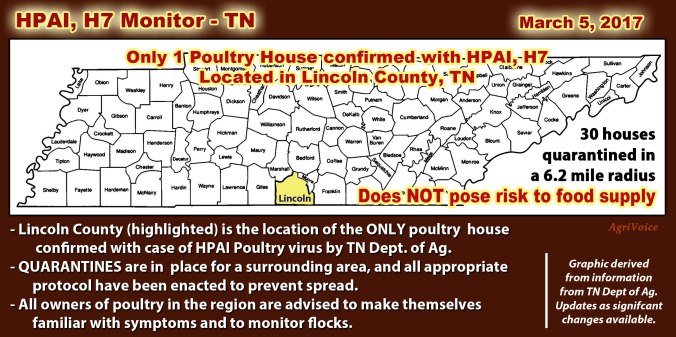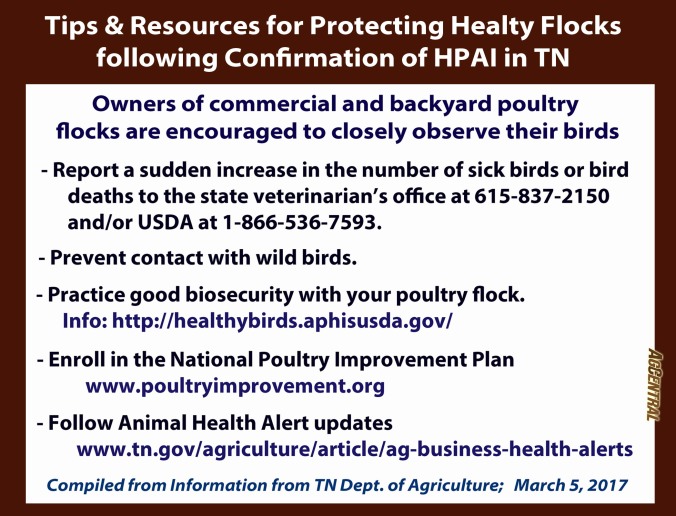
[UPDATE – March 6, 2017] Press Conference by Tennessee Department of Agriculture Officials, now archived and available for viewing on YouTube.
Summary of News Conference:
- Thus far, minimal impact. Biosecurity was excellent at the facility, and only 1 of 8 houses had clinical signs, however, the entire affected flock was depopulated / euthanized per disease control protocol.
- An initial round of testing in the surrounding area has proved to be negative, a positive sign, but several additional tests to follow.
- Any positive tests in neighboring flocks will reset and start a 2-week time clock again.
- A half dozen of the incident management team had experience with the national outbreak in 2015.
- Excellent records, and management expertise of farm owner, and a knowledge of what to do in certain situations, enabled this quick response.
- Exports will be impacted, not yet known to what degree.
- Thus far, for an extremely difficult situation, there has been a ‘best case scenario’ in a quick and effective response.
- Farm owner and the company who owns the birds (Tyson) are likely covered by some sort of indemnity program. The knowledge of what signs to look for in identifying the disease, and the skills of both enabled the farm owner to identify situation early and contact officials, critical to minimize the outbreak.
- Updates provided as indicated by the situation.
A ‘milkshed’ is part of a ‘foodshed,’ and poultry is a part of that worldwide foodshed. Therefore, this blog is taking a bit of a turn with this post.
I’ve got many colleagues and friends with poultry houses or backyard flocks, so as news broke from the Tennessee Department of Agriculture of an HPAI (Highly Pathogenic Avian Influenza) H7 confirmation in the lower middle region of TN on Sunday, March 5, 2017, the texts, posts, and industry emails began flying, and ag communicators got to work.
The first and most immediate point is that ‘HPAI does not post a risk to the food supply,’ according to TDA, as well as many other poultry organizations and animal health officials charged with protecting human health. This disease came to worldwide public attention in 2015 with major outbreaks in midwest poultry houses, turkeys, broilers, and chickens included. The Tennessee virus is of a different strain, H7, compared to H5, which was the culprit in the outbreaks two years ago.
As this post is written, there is apparently only 1 flock affected – a ‘breeder flock.’ Such a flock producers fertile eggs, to be hatched for broilers or laying hens. Per the protocol already in place, an immediate quarantine has been placed on 30 houses within a 6.2 mile radius of the affected poultry barn. Hopefully – very hopefully – this means the disease has been discovered early, and impact will be minimal.
It is to the credit of a vigilant and informed barn owner who realized something out of the ordinary was occurring, along with competent professional veterinarians, and an emergency preparedness protocol, that diagnosis was achieved quickly after the first reports to the TDA only two days prior. This is one example of the diligence, planning, and preparedness that makes the U.S. Food Supply the safest in the world.
Along with the initial news release, which has links to many other pieces of information, the Department expected there would be a press conference on Monday, March 6, 2017.
To answer questions in the first phase of the discovery, the TN Department of Agriculture has posted two YouTube videos, in which Dr. Charles Hatcher, TN State Veterinarian, answers the immediate issues, particularly the fact nothing from this flock – repeat NOTHING – has entered the human food supply. The videos can be viewed at these links:
PART 1 – HAPI interview, March 5, 2017: with Dr. Charles Hatcher, DVM, TN State Veterinarian
PART 2 – HAPI interview, March 5, 2017 also with Dr. Charles Hatcher, DVM
To get an idea of the scope of the matter on the first day of this incidence, this graphic should suffice. Hopefully, it won’t need too many updates, and this incidence can be contained quickly.

USDA statistics concerning the US Poultry industry tell us that TN is one of the Top 19 states in the nation for number of broilers.
A Voice of Experience: Lara Durben, MN Turkey Growers Association, Chicken & Egg Association of MN, Midwest Poultry Federation
Lara Durben, the Director of Communications for three major poultry organizations, the MN Turkey Growers Association, Chicken & Egg Association of Minnesota, and the Midwest Poultry Foundation, was at the forefront of communications when the first outbreaks occurred two years ago. MN was at the epicenter of the outbreak.
Lara was a lion, working to distribute information to poultry farms themselves, as well as being a factual, informed liasion for news outlets and consumers to get accurate information. Having seen an industry through the storm, she is a strong voice of experience.
I really appreciated her taking time from a Sunday afternoon to answer my requests for information. She indicated via messages she had already been contacted by others. She has suggested the following articles/resources; linked to here for your convenience:
Additionally, these were her contributions posted at Agriculture.com:
From Minnesota Turkey, with links to MN Extension publications:
Avian Influenza (An overview)
For BACKYARD POULTRY FLOCKS – From Minnesota, a state who has a vast amount of experience with avian influenza (a 2 pg. pdf to print)
For PASTURED and ORGANIC FLOCKS (Also from Minnesota – a 2 pg. pdf to print)
UPDATES (as they become available): Where to find them:
Tennessee Dept. of Ag: Alerts
University of TN Extension: New web page, launched on Monday, March 6
USDA APHIS: Biosecurity for Birds
And articles from the popular press and ag industry sources:
From the Guardian: a report sourced from the AP
Via Yahoo: another AP report, news affects stock prices of poultry companies
From Chicken Check-In: Contains info on current outbreak and what producers do to prevent avian flu.
From Watt AgNet: Timing of response from recognition of signs to diagnosis
From Tyson Foods: Owner of the birds, their ‘heightened security’ protocol and expectations
From the TN Poultry Association: Organization and Industry was already on high alert, due to season and timing of migratory flyways
For now, those with backyard and commercial flocks should not panic, yet review information related to the physiology of avian influenza. (see above).
Here is a list of resources that will be updated as needed:
